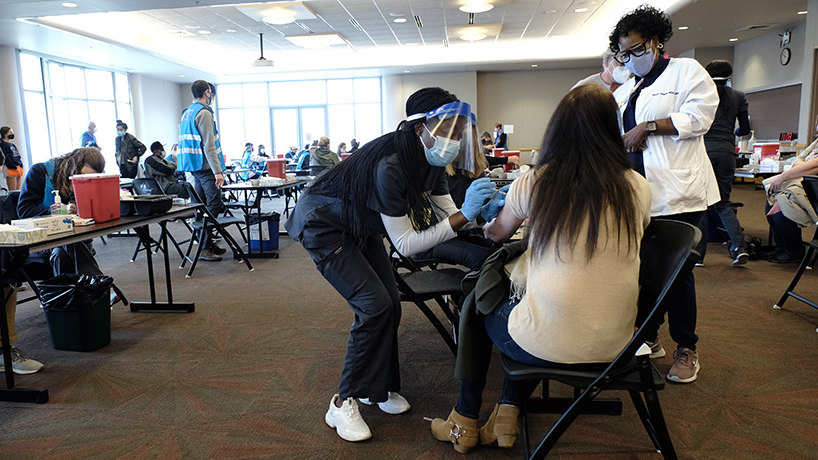
Investing in nursing education can help correct a chronic shortage of RN- and BSN-credentialed nurses nationally and at the state level that can impact health in the St. Louis region. (Photo by August Jennewein)
The nursing and medical professions are known for being responsible for the health and well-being of the state’s workforce. But they also have a large impact on Missouri’s economy.
The Missouri Hospital Association calculates that hospitals alone contribute $27.1 billion to Missouri’s Gross State Product. Missouri’s nurses – who number approximately 135,935 according to the Missouri Department of Professional Registration – make up about 4.8 percent of the state’s non-farm employment.
However, the nursing profession’s share could be even larger.
“Anyone who has had any kind of illness has an awareness of what nurses can do in the way of health care prevention and health care management,” said Roxanne Vandermause, interim dean of the College of Nursing at the University of Missouri–St. Louis. “There’s a general understanding that nurses are needed and a concern that there may not be enough.”
The issue is a chronic shortage of RN- and BSN-credentialed nurses nationally and also at the state level. In 2018, the MHA took the temperature at 32 Missouri and six Illinois hospitals to measure the extent of the staffing crisis in the region and discovered a nursing vacancy rate of 10 percent in the state, which is in-line with the national shortage.
That was before the COVID-19 pandemic, which has added significant strain to an already stressed system. That could have serious implications for the health and economic productivity of Missouri.
“This pandemic has shown us that when people are sick in the communities, and the hospitals become overloaded, then the health of the entire population is affected,” Vandermause said. “When an event causes overcrowding, nurses cannot provide elective care or do preventative work, and that increases illness and morbidity in the region. If we want to prevent all that, then we need to try to expand the workforce of health care practitioners.”
Underinvestment
Vandermause said that – even before the additional strain on the system from the increased needs during the pandemic – nursing has suffered from underinvestment that resulted in a gap in the flow of nurses earning credentials and entering the workforce.
That’s becoming an increasing problem as the current nurses enter retirement age without a ready supply of graduating nurses ready to step into those roles.
“A concentration of educators is needed to educate good nurses,” she said. “As money and investments in higher education wax and wane, nursing schools are affected by those budgetary constraints. The economy and how schools are funded make a difference in the number of faculty that educational programs can support.”
Without a robust instructor workforce, she notes, a school cannot increase the number of students it graduates without compromising quality.
Clinical preparation
Nursing students spend the tail end of their education in clinicals: hands-on, in-facility training under the supervision of a preceptor. But those partners might not have the capacity for an increased number of students.
Vandermause says that one solution is increasing one of the gold standards of nursing education: simulation, the replication of roleplay clinical scenarios based on real-world circumstances in a specialized lab with nursing faculty.
“Simulation education provides our nurses with an opportunity to experience a number of potential health care situations that we can’t guarantee in an actual hospital situation,” she said. “We use state-of-the-art mannequins, software programs and equipment that simulates an actual environment.”
She notes that the UMSL College of Nursing is in the process of increasing its ability to graduate more students by building a new 20,000 square foot simulation lab that will allow the college to increase its BSN-credentialed nurses by 20 percent annually.
A strong St. Louis
Vandermause believes that one of the most important parts of meeting the region’s needs is listening to clinical partners so that new nurses have the skills and expertise to address the most-pressing health issues of the region upon graduation.
That’s critical because UMSL nurses, specifically, play a large role in filling the nursing needs in the area.
“UMSL graduates are most often employed within six months of graduation,” she said. “A majority do remain in the St. Louis area, though they are educated to practice globally. But they often stay here to support health care in the region. Our area hospitals, clinics, schools and businesses are very interested in how many students that we provide each year and how well they function in the community.”
Learn more about the renovation and expansion of the Nursing Learning Resource and Simulation Center at the University of Missouri–St. Louis at https://www.umsl.edu/~nursingweb/nlrsc-campaign.html.
University of Missouri–St. Louis nursing graduates are equipped with the skills, knowledge and compassion needed to provide the highest levels of health care. UMSL educates more than 1,000 nursing students each year, the majority of whom are from Missouri. The College of Nursing offers bachelor’s and doctoral – PhD and DNP – degrees in nursing.
This story originally appeared in the St. Louis Business Journal’s Rise Up for St. Louis content hub, sponsored by the University of Missouri–St. Louis.














